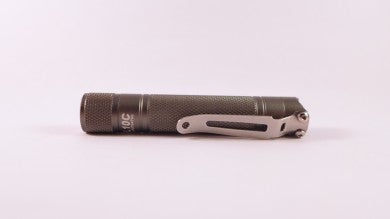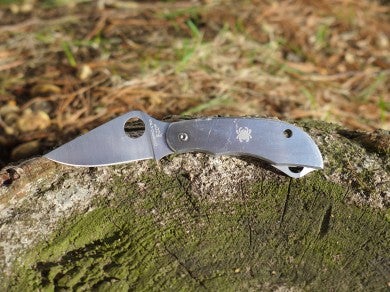EDC Recommendations 2014: $50 and Under
Tony Sculimbrene 09.17.14

Gear geeks will consider $25 each on a knife and a light as a pittance, but in reality, the vast majority of people own a light and saber pair in this price range. The challenge, it seems to me, is to figure out what you want to spend your dollars on. In the $25 price range you basically have to take what you are given, but here you have enough money to demand at least one really good thing–materials, design, carry–something. You don’t have enough to get an awesome well-rounded package, but at roughly $25 per tool, you can, if you are careful, get some damn good stuff.
Here is what I would recommend as the core part of your EDC if you have $50 to spend:
Knife: Victorinox Alox Cadet (Pictured above)
Light: L3 Illumination L10C Nichia 219 1xAA
The Victorinox Cadet is one of the best tool designs on planet Earth. There are basically two things you need to have to appreciate the Cadet–opposable thumbs and a beating heart. If you have those two things, you’re all set.
The Cadet’s steel is pretty blah, but it is made up for by the svelte size and the amazingly perfect tool complement. If you pay attention at all, the Cadet is not much of a surprise. People recommend it all the time. Look at high end gear, pocket dumps with a total value of more than a grand, and in many cases you will see a slim Cadet in the picture doing all of the real work to save the edge on a kilobuck custom.
Having written my site and here on AllOutdoor for a while, I will get emails asking what I would recommend, and more times than not, it’s the Cadet. It’s as slim as a very compact knife, squeezes some extra functionality in, and looks amazing.
But the light is a total shocker. L3 Illumination’s L10C is a sterling example of value and good, budget-conscious design. First, be careful as there is a twisty version without a clip, which is something I can’t recommend. The one-handed operation of a clicky design makes it too nice to ignore, but the L10C is more than just a clicky.
Basically for the price of an oLight I-series light, you get a clicky, a true moonlight low (.09 lumens!), and a Hi CRI emitter. Who would have thought, even a year ago, that we’d have a budget light with a Nichia 219 emitter? It would be like going to the Kia dealer and finding a car that competed with a Ferrari. For around $33 you get an amazing light with a ton of features that really matter. This isn’t the typical budget light that brags about some ludicrous lumens count or 50 modes, all but one of which are useless. This is a light made by someone that knows exactly how to allocate their design pennies. If it had a mode memory, the L10C would be a world beater. As it is, it has to settle for being the best value in flashlights circa 2014. I am not even going to bother with other considerations for the light; the L10C is so good it laps the field.
Other Considerations
If you don’t want a Cadet, there are three pliers-based multitools I like that fit the budget.
First is the Gerber Dime. As a keychain multitool, it’s tiny, and while it has pliers, don’t expect them to be able to really wrench on stuff. If you need something light duty, it is quite good.
One problem though: the fit and finish on the Dime is, as with all Gerber stuff, exceptionally spotty. My review sample was perfect, but one I purchased as a gift was dreadful. If you roll the dice and get lucky, it’s a winner at just around $20.
The other two pliers-based multitools I like in this price range are the Leatherman PS4 and the Wingman. The PS4 is basically a Dime with more consistent fit and finish and the glow of being made in the USA. The Wingman, however, is a full sized tool with a great tool complement: scissors, a one handed opening knife, and my favorite new implement, the clam shell cutter. If you are careful or wait until Black Friday, you can score a Wingman for around $25, but even the normal price of $30-$33 is still good.
Another option here is to go with the new Spyderco multitools, the Clipitools. There are three, but a close examination shows that one is better than the others. With its driver/bottle opener tool, the Driver Clipitool is the most versatile choice.
The other two, with their scissors or serrated blade respectively, offer lots of cutting options but little else. The fit and finish is great and I really liked the Driver Clipitool a great deal, but its thickness and orthopedic look put it behind the slim and graceful Cadet in terms of recommendations. The blade on the Clipitool is a better design, but that is about it.
For knives only in this price range, two stand out: the CRKT Drifter and the Kershaw Chill.
The Drifter is probably the best value in knives, though I would opt for the weight savings of the G10 model over the stainless framelock. The blade steel, 8Cr14MoV, is decent and virtually identical to 8Cr13MoV. The pivot is amazing and deployment is nothing more than a quick thumb flick–no wrist action required.
The Chill was similarly easy to open. It’s an uber-cheap, $20 folder designed by the King of the Flippers, RJ Martin. Martin’s customs go for more than a grand, and having handled one, it is easy to see why. The flipping action is so good it’s almost as if the knife is a telepath. Here, that flipper know-how really shows. The Chill pops open quickly and easily. It also happens to be thin and feather light. The steel is the decent but not great 8Cr13MoV.
I’d probably be remiss if I didn’t mention the KaBar Mini Dozier, which runs AUS8 steel, but its feel and build quality is a step below the Drifter and the Chill. A generation ago it was the Budget Blade Champ, but the title has gone to the Drifter now.

